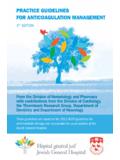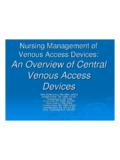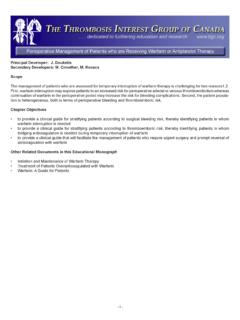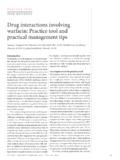Transcription of Wingspan Stent System with PTA Balloon Catheter Delivering ...
1 Wingspan Stent System with Gateway PTA Balloon Catheter Delivering New options for Ischemic Stroke 1,2. The risk of ischemic stroke in patients with Intracranial Atherosclerotic Disease (ICAD) ranges from 7 to 24%. Developed specifically for the treatment of ICAD, the Wingspan Stent System and Gateway PTA Balloon Catheter deliver new options for ischemic stroke. Designed for Neurovascular Access The Wingspan Stent System features a highly flexible, trackable delivery System designed to facilitate access through challenging neurovascular anatomy. Vessel Wall Apposition The Wingspan Stent employs an extra-flexible, self-expanding Stent designed to promote vessel wall apposition in curved and tapered vessels.
2 The Stent features a flexible cell design for enhanced conformability and to facilitate access, especially with longer Stent lengths. Vessel Lumen Support Wingspan Stents are designed to support the vessel lumen by minimizing vessel recoil following angioplasty and exerting active, controlled, outward radial force. Wingspan Stent System Hydrophilic Product Number Diameter x Length Labeled Stent Self-Expanded Recommended Diameter Stent Diameter Vessel Diameter x 20 mm mm .. mm ..> and mm x 20 mm mm .. mm ..> and mm x 20 mm mm .. mm ..> and mm x 20 mm mm .. mm ..> and mm x 20 mm mm.
3 Mm ..> and mm x 15 mm x 15 mm x 15 mm Unified Over-the-Wire (OTW) Stent Delivery System x 15 mm in Guidewire Compatible x 15 mm 6F (minimum in ID) Guide Catheter Compatible x 9 mm Strut Thickness: in x 9 mm Strut Width: in x 9 mm Stent Foreshortening: x 9 mm x 9 mm 1 Comparison of Warfarin and Aspirin for Symptomatic Intracranial Arterial Stenosis. N Engl J Med 352;13, March 31, 2005. 2 Failure of Extracranial-Intracranial Arterial Bypass to Reduce the Risk of Ischemic Stroke: Results of an International Randomized Trial. N Engl J Med 1985; 313:1191 1200. ETG100 1. Wingspan Stent System with Gateway PTA Balloon Catheter Delivering New options for Ischemic Stroke Gateway PTA Balloon Catheter Hydrophilic Product Number Diameter x Length Product Number Diameter x Length x 20 mm 207221530.
4 X 15 mm x 20 mm 207221532 .. x 15 mm x 20 mm 207221535 .. x 15 mm x 20 mm 207221537 .. x 15 mm x 20 mm 207221540 .. x 15 mm x 20 mm 207220915 .. x 9 mm x 20 mm 207220920 .. x 9 mm x 20 mm 207220922 .. x 9 mm x 20 mm 207220925 .. x 9 mm x 20 mm 207220927 .. x 9 mm x 15 mm 207220930 .. x 9 mm x 15 mm 207220932 .. x 9 mm x 15 mm 207220935 .. x 9 mm x 15 mm 207220937 .. x 9 mm x 15 mm 207220940 .. x 9 mm Procedure Overview 1. Gentle Pre-Dilation The Gateway PTA Balloon Catheter features a semi-compliant Balloon designed for controlled, low-pressure inflation (6 atm).* Recommended to be undersized to 80% of the target vessel diameter, it provides for gentle pre-dilation prior to Stent deployment.
5 2. Atraumatic Stent Deployment Engineered for atraumatic deployment, the Wingspan Stent is designed to apply minimal pressure less than atm* to the vessel wall immediately proximal and distal to the treated lesion. 3. Highly Conformable Stent Design The Wingspan Stent is a self-expanding design with flexible cells to enhance conformability and vessel wall apposition in curved and tapered vessels. 4. Outward Radial Force The Wingspan Stent is designed to support the vessel lumen by minimizing vessel recoil following angioplasty and exerting active, controlled, outward radial force.*.
6 * Data on file at Boston Scientific. Bench test results may not be indicative of clinical performance. ETG100 2. Wingspan Stent System with Gateway PTA Balloon Catheter Delivering New options for Ischemic Stroke HDE Safety Study The Wingspan Stent System and Gateway PTA Balloon Catheter have been evaluated in a monitored, adjudicated, multicenter study. In this study, half the lesions treated were in the anterior circulation demonstrating the access capabilities of this groundbreaking System . The clinical performance of the Wingspan Stent System and Gateway PTA Balloon Catheter , as shown in this clinical study, included a procedural success rate of HDE Study Results Multi-Center Study Monitored, adjudicated study at 12 sites; 45 patients enrolled Proven Safety Procedure success = (43/44).
7 0 vessel dissections, 0 vessel ruptures Access 50% of cases in anterior circulation 9 M1 lesions treated Clinical Outcomes 30-day ipsilateral stroke or death rate = (2/45). 6-month ipsilateral stroke or death rate = (3/43). > 50% Stenosis (3/40) at 6 months 24 out of 40 patients experienced increase in lumen diameter (post-procedure vs. 6-month follow-up). Symptomatic Restenosis 0% (0/40) at 6 months ETG100 3. Wingspan Stent System with Gateway PTA Balloon Catheter Delivering New options for Ischemic Stroke See package insert for complete indications, contraindications, warnings, and instructions for use.
8 Humanitarian Device. The Wingspan Stent System with Gateway PTA Balloon Catheter is authorized by United States Federal law for use in improving cerebral artery lumen diameter in patients with intracranial atherosclerotic disease, refractory to medical therapy, in intracranial vessels with 50% stenosis that are accessible to the System . The effectiveness of this device for this use has not been demonstrated. Wingspan Stent System Indications For Use The Wingspan Stent System with Gateway PTA Balloon Catheter is indicated for use in improving cerebral artery lumen diameter in patients with intracranial atherosclerotic disease, refractory to medical therapy, in intracranial vessels with 50% stenosis that are accessible to the System .
9 Contraindications Patients in whom antiplatelet and/or anticoagulation therapy is contraindicated. Lesions that are highly calcified or otherwise could prevent access or appropriate expansion of the Stent . Potential Adverse Effects The potential adverse events listed below, as well as others, may be associated with the use of the Wingspan Stent System with Gateway PTA. Balloon Catheter or with the procedure: Observed Adverse Events: Infection; TIA; Stroke; Hematoma; Vasospasm; Hemorrhagic Event; Hypertension; Peripheral vascular diseases;. Neurological symptoms; Pain; AMI; Angina; Arrhythmia; Creatinine increase; Hematuria; Hypoglycemia/hyperglycemia; Asymptomatic Thromboembolic Event; Bradycardia (35 min); Broken middle-foot left/V-fracture; Chronical antrum gastritis; Death; Elevated bilirubin, GOT, GPT.
10 Fever; Hiatus hernia; Hypervolemia; New distal in Stent stenosis; Pulmonary edema; respiratory failure; Seizure; Syncope Potential Adverse Events: Cerebral aneurysm; Coagulopathy; Emboli (air, tissue, or thrombotic tissue); Intimal dissection; Pseudoaneurysm; Stent migration; Stent misplacement; Stent occlusion; Stent embolization; Stent thrombosis; Vessel perforation; Vessel rupture; Vessel thrombosis;. Vessel trauma requiring repair or surgical intervention Please be aware that potential adverse effects may arise even with the proper use of medical devices. Accordingly, this device should only be used by persons qualified in the procedures for which it is indicated.










